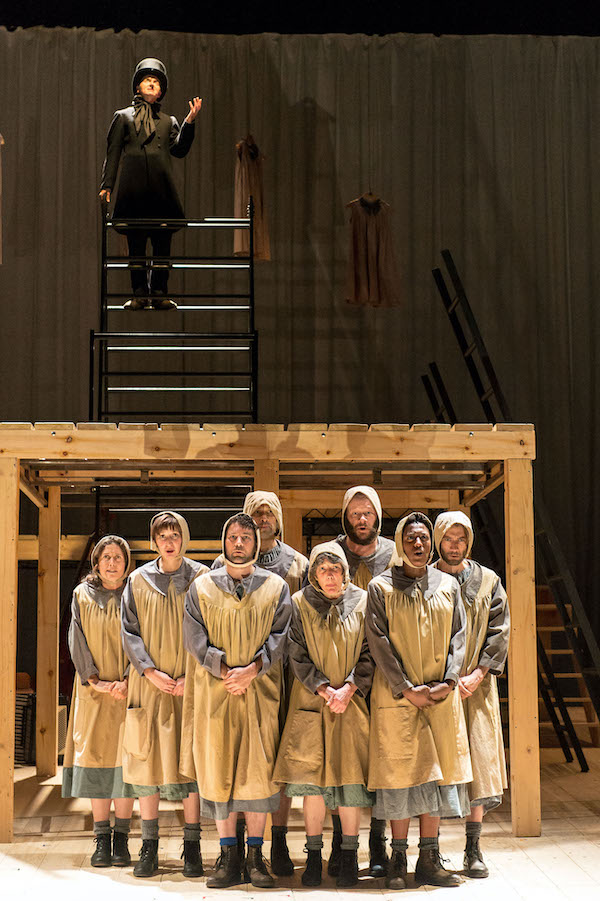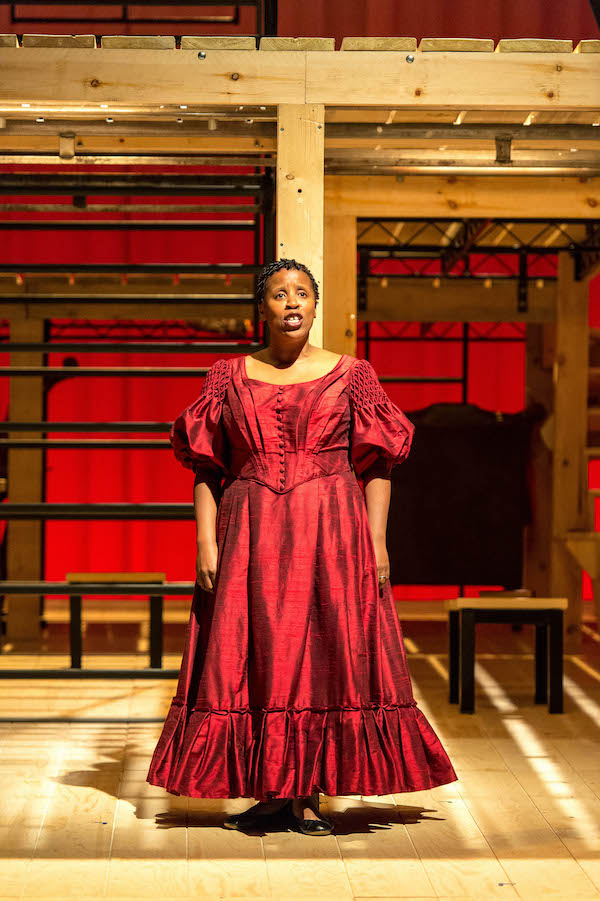Jane Eyre, National Theatre at Home review - a fiery feminist adaptation | reviews, news & interviews
Jane Eyre, National Theatre at Home review - a fiery feminist adaptation
Jane Eyre, National Theatre at Home review - a fiery feminist adaptation
Sally Cookson's take on Brontë is innately theatrical and ferociously resonant

The National Theatre’s online broadcasts got off to a storming start with One Man, Two Guvnors – watched by over 2.5 million people, either on the night or in the week since its live streaming, and raising around £66,000 in donations.
Cookson’s devised work blows past the problems associated with transferring literature to stage. There is nothing stuffy or static about her version; on the contrary, this is an intensely physical and multisensory piece. Throughout, we feel Jane Eyre’s (the terrific Madeleine Worrall) fervent wish for stimulation, for adventure. “I must have liberty, and if I can’t have liberty then I must have change,” she gasps, her flinging open a window (main picture) a radical act.
 While other adaptations centre the romance, Cookson makes clear that this is Jane’s life story, in which she, and other women, chafe against the restrictions placed on their sex. Notably, the production is bookended by the defining phrase “It’s a girl”. Jane is constantly forced into a too-small space, whether locked in the Red Room by her cruel aunt, made to stand on a tiny stool by the bullying proprietor of Lowood School, Mr Brocklehurst (pictured above right), or simply fenced in by traditional female pursuits like quiet sewing when she longs to be challenged, to shout and run and grow. Worrall puts real ferocity into the words “Women feel just as men feel”.
While other adaptations centre the romance, Cookson makes clear that this is Jane’s life story, in which she, and other women, chafe against the restrictions placed on their sex. Notably, the production is bookended by the defining phrase “It’s a girl”. Jane is constantly forced into a too-small space, whether locked in the Red Room by her cruel aunt, made to stand on a tiny stool by the bullying proprietor of Lowood School, Mr Brocklehurst (pictured above right), or simply fenced in by traditional female pursuits like quiet sewing when she longs to be challenged, to shout and run and grow. Worrall puts real ferocity into the words “Women feel just as men feel”.
Of course, everyone right now can relate to Jane’s yearning to escape her physical imprisonment, but it’s the spiritual and psychological containment that this production so vividly communicates. Her riposte to Mr Rochester is a mighty roar: “I am no bird; and no net ensnares me. I am a free human being with an independent will.” Cookson gives the story fiery resonance by stressing the terrible deprivation visited on those who have less money or are otherwise disadvantaged in society, and who are told to be grateful if they receive the bare necessities. Jane will not: she demands kindness, opportunity, love and respect, and she rails against inequality and injustice.
Her arduous journey to seek fulfilment is visually conveyed by Michael Vale’s playground-like set, in which Worrall is constantly struggling up ladders, hampered by her skirts and corset. It’s an effective spine for this stripped-back piece, which ditches period drama trappings and instead asks the audience to envision this world, although the actors’ athletic conquering of their obstacle course sometimes distracts. But the set gains another dimension from Aideen Malone’s expressionistic lighting, with bold colour washes that reflect Jane’s emotional state, and handheld lamps to leave secrets lurking in the shadows of Thornfield Hall.
 Cookson also gives constant voice to the ‘madwoman in the attic’, Bertha Mason, with Melanie Marshall’s soulful singing (pictured left) the centrepiece of Benji Bower’s heart-pounding score. It binds Bertha to Jane in a grim kinship: two women who are mistreated, misunderstood, trapped and brutalised, and who in turn lash out, albeit to different degrees. Yet we only learn of Bertha’s violent state from an external source, while we, the audience, still hear her song – her palpable desire for affection.
Cookson also gives constant voice to the ‘madwoman in the attic’, Bertha Mason, with Melanie Marshall’s soulful singing (pictured left) the centrepiece of Benji Bower’s heart-pounding score. It binds Bertha to Jane in a grim kinship: two women who are mistreated, misunderstood, trapped and brutalised, and who in turn lash out, albeit to different degrees. Yet we only learn of Bertha’s violent state from an external source, while we, the audience, still hear her song – her palpable desire for affection.
The excellent company multi-roles and acts as chorus for Jane, amplifying her thoughts and dilemmas. Among them, Felix Hayes is a bitter, seething Rochester, tormented by his failings, who sees in Jane not just love but some kind of solace. Laura Elphinstone gives us a hyperactive young Adele, and makes the saintly Helen bearable by portraying her as an empathetic, perceptive pragmatist. Craig Edwards’ Mr Brocklehurst embodies the repressive, status-obsessed church, and Edwards is also thoroughly delightful scrambling about the stage as Pilot the dog. Simone Saunders is a kindly Bessie and snooty Blanche Ingram, while Maggie Tagney provides a cheerily bustling Mrs Fairfax, but imbues Jane’s aunt with real venom.
Although Cookson makes every narrative element engaging, including the energetic journeying, this three-hour-plus production (originally a two-part adaptation) does feel overlong – and the book’s structure means there’s an inevitable Act II lag when Jane departs Thornfield. It’s lacking, too, Brontë’s vivid sense of place. But it’s beautifully presented in NT Live’s filming, and, with its emphasis on valuing everyone, and on the power of the imagination to help us transcend our enclosures, it’s another clever choice for shutdown viewing – plus a bold, creative production to share with a wide audience.
- Jane Eyre on the National Theatre’s YouTube channel until 16 April
- Read more theatre reviews on theartsdesk
rating
Explore topics
Share this article
Add comment
The future of Arts Journalism
You can stop theartsdesk.com closing!
We urgently need financing to survive. Our fundraising drive has thus far raised £49,000 but we need to reach £100,000 or we will be forced to close. Please contribute here: https://gofund.me/c3f6033d
And if you can forward this information to anyone who might assist, we’d be grateful.

Subscribe to theartsdesk.com
Thank you for continuing to read our work on theartsdesk.com. For unlimited access to every article in its entirety, including our archive of more than 15,000 pieces, we're asking for £5 per month or £40 per year. We feel it's a very good deal, and hope you do too.
To take a subscription now simply click here.
And if you're looking for that extra gift for a friend or family member, why not treat them to a theartsdesk.com gift subscription?
more Theatre
 Ragdoll, Jermyn Street Theatre review – compelling and emotionally truthful
Katherine Moar returns with a Patty Hearst-inspired follow up to her debut hit Farm Hall
Ragdoll, Jermyn Street Theatre review – compelling and emotionally truthful
Katherine Moar returns with a Patty Hearst-inspired follow up to her debut hit Farm Hall
 Troilus and Cressida, Globe Theatre review - a 'problem play' with added problems
Raucous and carnivalesque, but also ugly and incomprehensible
Troilus and Cressida, Globe Theatre review - a 'problem play' with added problems
Raucous and carnivalesque, but also ugly and incomprehensible
 Clarkston, Trafalgar Theatre review - two lads on a road to nowhere
Netflix star, Joe Locke, is the selling point of a production that needs one
Clarkston, Trafalgar Theatre review - two lads on a road to nowhere
Netflix star, Joe Locke, is the selling point of a production that needs one
 Ghost Stories, Peacock Theatre review - spirited staging but short on scares
Impressive spectacle saves an ageing show in an unsuitable venue
Ghost Stories, Peacock Theatre review - spirited staging but short on scares
Impressive spectacle saves an ageing show in an unsuitable venue
 Hamlet, National Theatre review - turning tragedy to comedy is no joke
Hiran Abeyeskera’s childlike prince falls flat in a mixed production
Hamlet, National Theatre review - turning tragedy to comedy is no joke
Hiran Abeyeskera’s childlike prince falls flat in a mixed production
 Rohtko, Barbican review - postmodern meditation on fake and authentic art is less than the sum of its parts
Łukasz Twarkowski's production dazzles without illuminating
Rohtko, Barbican review - postmodern meditation on fake and authentic art is less than the sum of its parts
Łukasz Twarkowski's production dazzles without illuminating
 Lee, Park Theatre review - Lee Krasner looks back on her life as an artist
Informative and interesting, the play's format limits its potential
Lee, Park Theatre review - Lee Krasner looks back on her life as an artist
Informative and interesting, the play's format limits its potential
 Measure for Measure, RSC, Stratford review - 'problem play' has no problem with relevance
Shakespeare, in this adaptation, is at his most perceptive
Measure for Measure, RSC, Stratford review - 'problem play' has no problem with relevance
Shakespeare, in this adaptation, is at his most perceptive
 The Importance of Being Earnest, Noël Coward Theatre review - dazzling and delightful queer fest
West End transfer of National Theatre hit stars Stephen Fry and Olly Alexander
The Importance of Being Earnest, Noël Coward Theatre review - dazzling and delightful queer fest
West End transfer of National Theatre hit stars Stephen Fry and Olly Alexander
 Get Down Tonight, Charing Cross Theatre review - glitz and hits from the 70s
If you love the songs of KC and the Sunshine Band, Please Do Go!
Get Down Tonight, Charing Cross Theatre review - glitz and hits from the 70s
If you love the songs of KC and the Sunshine Band, Please Do Go!
 Punch, Apollo Theatre review - powerful play about the strength of redemption
James Graham's play transfixes the audience at every stage
Punch, Apollo Theatre review - powerful play about the strength of redemption
James Graham's play transfixes the audience at every stage
 The Billionaire Inside Your Head, Hampstead Theatre review - a map of a man with OCD
Will Lord's promising debut burdens a fine cast with too much dialogue
The Billionaire Inside Your Head, Hampstead Theatre review - a map of a man with OCD
Will Lord's promising debut burdens a fine cast with too much dialogue

Comments
I've just watched this on TV